Text
imd_ plant transistor- talking plants
11.06.2021 - 16.03.2022
On the occasion of the 150th anniversary of the Palmengarten, designers and artists have dealt with the Palmengarten and its "transformations" over time.
Students of the Institute for Material Design IMD of the Offenbach University of Art and Design designed a pavilion for this purpose, which contains the meaning of the Palmengarten as a meeting place between plants, nature and humans. The focus is primarily on the symbiotic dialogue between nature and culture.
The basic structure of the pavilion is based on the natural form of the Fibonacci sequence and its logic is further developed into an architectural spatial structure. Bundled willow rods form the open basic structure, which is covered with a white multilayer textile membrane, creating a very unique spatial atmosphere. The pavilion is overgrown with plants both from the inside and outside, which over time completely overgrow and take over the pavilion as an artifact. By means of a sound and light installation, a bridge can be built to technology during this interaction between nature and culture. Through a sensor system attached to the plants, impulses are measured and their interactions and reactions with the environment are transformed into a sound and light image. An auditory and visual atmosphere is created that reacts interactively to each visitor. At the same time, the hidden network of plants, characterized by communication and reactions, is illustrated. Thus, the "imd_plant transistor" itself becomes an experimental research biotope.
0 notes
Text
imd_ plant transistor-talking plants
11.06.2021 - 16.03.2022
Anlässlich des 150-jährigen Palmengartenjubiläums haben sich Gestalter_innen und Künstler_innen mit dem Palmengarten und seinen „Transformationen“ im Wandel der Zeit auseinandergesetzt.
Studierende des Instituts für Materialdesign IMD der Hochschule für Gestaltung in Offenbach gestalteten hierfür einen Pavillon, der die Bedeutung des Palmengartens als Begegnungsort zwischen Pflanze, Natur und Mensch beinhaltet. Dabei steht vor allem der symbiotische Dialog von Natur und Kultur im Fokus.
Die Grundstruktur des Pavillons baut auf der natürlichen Form der Fibonacci-Folge auf und wird in ihrer Logik zu einer architektonischen Raumstruktur weitergedacht. Gebündelte Weidenruten bilden dabei die offene Grundstruktur, die mit einer weißen mehrlagigen Textil-Membran überspannt ist und so eine ganz eigene Raumatmosphäre erzeugt. Der Pavillon ist sowohl von Innen als auch von Außen mit Pflanzen bewachsen, die im Laufe der Zeit den Pavillon als Artefakt vollkommen überwuchern und übernehmen. Anhand einer Sound- und Lichtinstallation lässt sich während dieser Interaktion zwischen Natur und Kultur eine Brücke zur Technik schlagen. Durch eine an die Pflanzen angebrachte Sensorik werden Impulse gemessen und ihre Interaktionen und Reaktionen mit der Umgebung in ein Sound- und Lichtbild transformiert. Es entsteht eine auditiv und visuell wahrnehmbare Atmosphäre, die interaktiv auf jeden Besucher reagiert. Zeitgleich wird das von Kommunikation und Reaktionen geprägte verborgene Netzwerk der Pflanzen veranschaulicht. Somit wird der „imd_plant transistor“ selbst zu einem experimentellen Forschungsbiotop.
Betreuung: Prof. Dr.-Ing. Arch. Markus Holzbach, Dipl.-Des. Valentin Brück
Teilnehmer_innen: Lisa Bartz, Kira Bernauer, Sophie Bernauer, Johannes Bietz, Till Eser, Lucas Glittenberg, Noa Haller, Nina Jäcker, Lennard Ludig, Zachary Mentzos, Leonard Neunzerling, Josephine Pavesi, Daniel Wolff
Besonderer Dank an das Palmengarten Team, Stephan Blanché, Michael Langsdorf, Adrian Kitzinger, Robert Langer, Ziyu Zhou
IMD in cooperation with / in Zusammenarbeit mit Palmengarten Frankfurt
0 notes
Photo
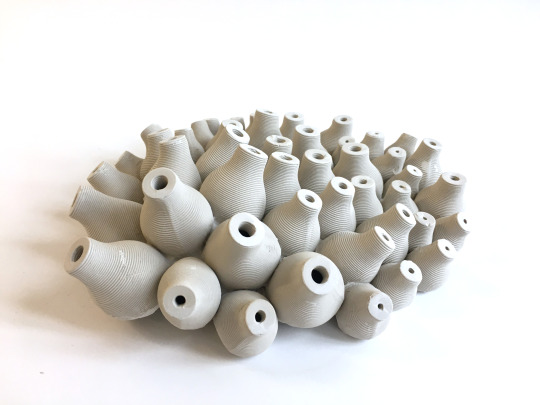
“Coon” ist ein 3D-gedrucktes Insektenhotel aus Keramik. Durch die Verschneidung von Technik und Natur, kann unmittelbar auf das Insektensterben eingegangen werden.
Projekt von: Kira Bernauer
0 notes
Text
Three-dimensional ceramic print
By experimenting with materials and semi-finished products that have an identical or similar shape, shape-defining structures are to be generated or found. The focus is on the use of the 3D ceramic printer. Central aspects are the designer’s will to create, the form-determining logic of the material and/or the opportunities and restrictions of the shaping processes used.
Dreidimensionaler Keramikdruck
Durch die experimentelle Auseinandersetzung mit Materialien und Halbzeugen, die über eine identische oder ähnliche Gestalt verfügen, sollen formbestimmende Strukturen generiert oder gefunden werden. Der Fokus liegt auf dem Einsatz des 3D-Keramikdruckers. Zentrale Aspekte sind dabei der entwerferische Gestaltungswille, die formbestimmende Logik des Materials und/oder die Chancen und Restriktionen der eingesetzten Formgebungsverfahren.
Prof. Dr. Markus Holzbach Institut für Materialdesign IMD Kunsthochschule HfG Offenbach
Projektleitung: Prof. Dr. Markus Holzbach
Projektbetreuung: Dipl. Des. Valentin Brück, Lennard Wilde
Teilnehmer_innen: Christian Struwe, Christina Timmann, Jun Jin, Philip Kleine, Homa Soleimani, Johann Rambow, Lukas Loscher, Isenia Spatola, Celina Almendarez, Kira Bernauer, Nika, Gavran, Jonas Nitsch, Noa Haller, Marlene Bruch, Julia Huber, Yujin Kang
0 notes
Text
Sneature
Sneature is the design of a waste-based sneaker. Upcycled waste- and raw materials were explored which led to the development of a biological material cycle for a sneaker. The use of additive manufacturing methods, such as 3D printing or 3D knitting, enable both individualization and on-demand production with the lowest possible energy consumption.Reducing the product to its minimal components, it consists of a membrane made of chiengora (yarn made from dog hair), a transitional area made of natural rubber, and a sole made of mushroom mycelium. After use, Sneature is biodegradable and can be returned as nutrients to the natural material cycle.Supervision: Prof. Dr. Markus HolzbachCooperation: Modus Intarsia
Sneature
Sneature ist der Entwurf eines abfallbasierten Turnschuhs. Upgecycelte Roh- und Abfallstoffe wurden für die Entwicklung eines biologischen Materialkreislaufes untersucht. Die Verwendung von additiven Fertigungsmethoden, wie 3D-Druck oder 3D-Stricken, ermöglicht sowohl eine individuelle Anpassung an den Nutzer als auch eine On-Demand-Produktion bei minimalem Energieaufwand. Das auf seine minimalen Bestandteile reduzierte Produkt besteht aus einer Membran aus Chiengora (Garn aus Hundehaaren), einem Übergangsbereich aus Naturkautschuk und einer Sohle aus Pilzmyzel. Nach Gebrauch ist Sneature biologisch abbaubar und kann somit als Nährstoffe in den natürlichen Stoffkreislauf rückgeführt werden.
Diplom von: Emilie Burfeind
Betreuung: Prof. Dr. Markus Holzbach
Kooperation: Modus Intarsia
1 note
·
View note
Photo


Eco_Morphia
Die Installation „ECO_MORPHIA“ stellt einen symbiotischen Dialog von Natur und Kultur dar. Häufig versucht in solchen Natur-Kultur-Korrelationen eines der Systeme ein anderes zu übernehmen und erfahrungsgemäß dominiert dabei die Kultur nur allzu häufig die Natur. Die eigentliche Faszination liegt auf dem scheinbar unerschöpflichen Adaptionsvermögen der Natur und der Interaktion der belebten Natur mit der vom Menschen gestalteten Umwelt. Die Installation entstand im Rahmen des Projekts ‚Natur Kultur‘ am von Prof. Dr. Markus Holzbach geleiteten Institut für Materialdesign IMD an der Hochschule für Gestaltung Offenbach. Ziel war es, ein System zu entwickeln, welches sich durch strukturelle Flexibilität an natürliche und materielle Herausforderungen anpassen kann. Ein System, welches primär nicht zur Aufgabe hat, die Kultur durch reine Nachahmung der Natur zu bereichern, sondern eine abstrahierte Symbiose zu schaffen und aus dieser „Zweckgemeinschaft“ neue Kenntnisse zu erlangen. Die resultierende Raumstruktur ist ephemer und zu 100% recycelbar, sie bietet eine Bühne für die Wiederverwertung bereits ausgedienter Pflanzen und Organismen des Palmengartens und wird so zu einem experimentellen Forschungsbiotop.
Eco_Morphia
The installation "ECO_MORPHIA" represents a symbiotic dialogue between nature and culture. In such nature-culture correlations, one of the systems often tries to take over another, and experience shows that culture all too often dominates nature. The real fascination lies in nature's seemingly inexhaustible capacity for adaptation and the interaction of animate nature with the man-made environment. The installation was created as part of the 'Natur Kultur' project at the Institute for Material Design IMD at the Offenbach University of Art and Design, directed by Prof. Dr. Markus Holzbach. The aim was to develop a system that can adapt to natural and material challenges through structural flexibility. A system that does not primarily have the task of enriching culture through pure imitation of nature, but rather to create an abstract symbiosis and to gain new knowledge from this "community of purpose". The resulting spatial structure is ephemeral and 100% recyclable. It provides a stage for the recycling of already disused plants and organisms of the Palm Garden and thus becomes an experimental research biotope.
Prof. Dr. Markus Holzbach Institut für Materialdesign IMD Kunsthochschule HfG Offenbach
Projektleitung: Prof. Dr. Markus Holzbach
Projektbetreuung: Dipl.-Ing. Tatjana Gorbachewskaja
Teilnehmer: Lara Bohe, Delphine Collet, Marius Dittmar, Seyed Arash Mousavi Gharavi, Philip Landgrebe, Lucas Glittenberg, Andreas Grimm, Catharina Köhler, Dylan McGuire, Leonie Morbach, Cornelia Stehling
IMD in cooperation with / in Zusammenarbeit mit
Palmengarten Frankfurt & Btv-Furniere GmbH
0 notes
Photo
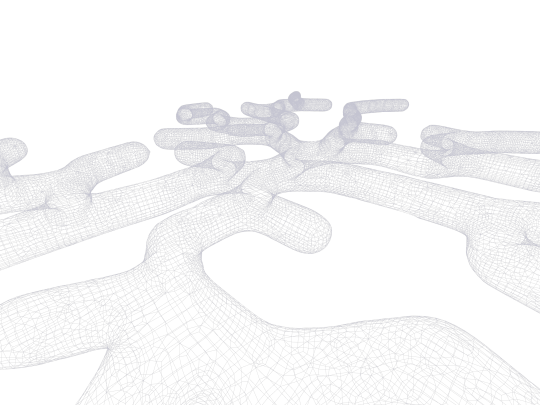
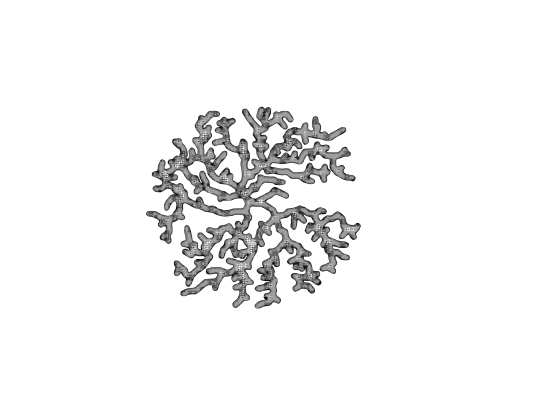
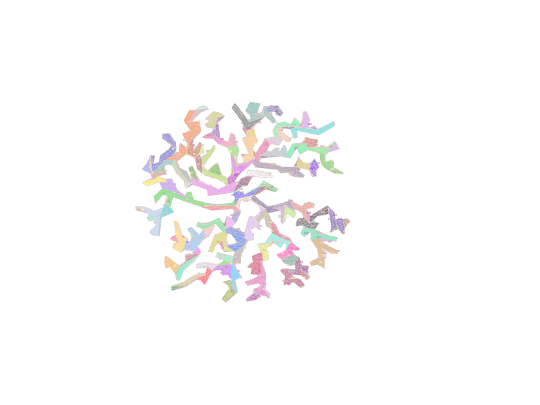

digital nature
The intersection of nature and technology is increasing steadily. Not only are bionic principles abstracted from nature into technological processes, but the use of natural materials in design is also increasing. In my project digital nature I have been dealing with the implementation of minimal surfaces occurring in nature into an algorithmically calculable spatial structure that can be physically developed as 2D patterns. The aspect of digital fabrication was an important part of the project. The multi-curved surfaces could be unwound into a planar pattern and reassembled as a three-dimensional spatial structure.
digital nature
Die Verschneidung von Natur und Technologie nimmt immer mehr zu. Es werden nicht nur bionische Prinzipien aus der Natur in technologische Prozesse abstrahiert, sondern nimmt auch die Verwendung natürlicher Materialien in der Gestaltung zu. In meinem Projekt digital nature habe ich mich mit der Implementierung von in der Natur vorkommenden Minimalflächen in eine algorithmisch berechenbare und als 2D-Schnittmuster physisch abwickelbare Raumstruktur auseinandergesetzt. Dabei war der Aspekt digital fabrication ein wichtiger Bestandteil des Projektes. Die mehrfach gekrümmten Flächen konnten in ein planares Schnittmuster abgewickelt und wieder als dreidimensionale Raumstruktur zusammgefügt werden.
Andreas Grimm
0 notes
Photo
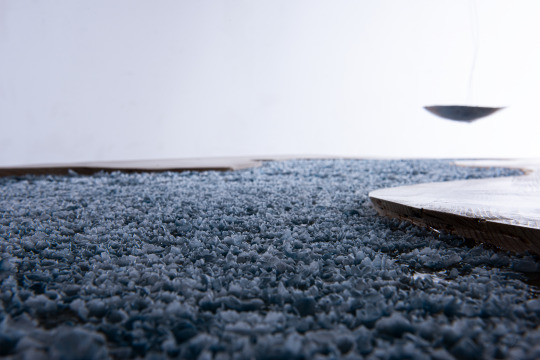
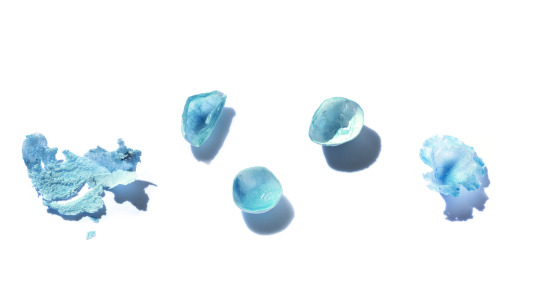
Fractal Chaos
The focus of the project ‚Fractal Chaos‘ is put on exploring repeatable yet unpredictable shapes. The goal was to generate shapes not through artificially planned, conceptualized, classic design processes but through natural force impact. While heated and therefore liquid, the material was implemented in to several different liquids. The varying shapes are a result of the varying surface tension. Repeatability was proven throughout the experiments. To visualize the experiments the process was automated. For this purpose, a catch basin was generated, which approximates aesthetic form of natural waters basins and recites the dripping of the material by concentric basin divisions.
Fractal Chaos
Die Arbeit ‚Fractal Chaos’ setzt sich mit der Wiederholbarkeit des Unvorhersehbaren auseinander. Ziel war es, die Formgestaltung durch einen nicht artifiziell geplanten, konzeptualisierten, klassischen Designprozess zu generieren, sondern durch natürliche Krafteinwirkung. Im erhitzten, somit flüssigen Zustand, wurde das Material aus verschiedenen Höhen in verschiedenen Flüssigkeiten implementiert. Die Formvarianz entstand durch Varianz in der Oberflächenspannung der einzelnen Versuchsaufbauten. Die Wiederholbarkeit konnte eindeutig in den Versuchen bestätigt werden. Zur Visualisierung wurde der Prozess automatisiert. Dazu wurde ein Auffangbecken generiert, welches sich formelästhetisch natürlichen Gewässern annähert und durch konzentrische Beckenunterteilung das Topfen des Materials rezitiert.
Lara Bohe
0 notes
Photo
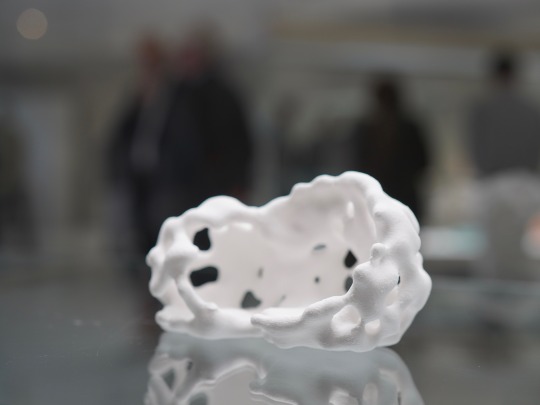
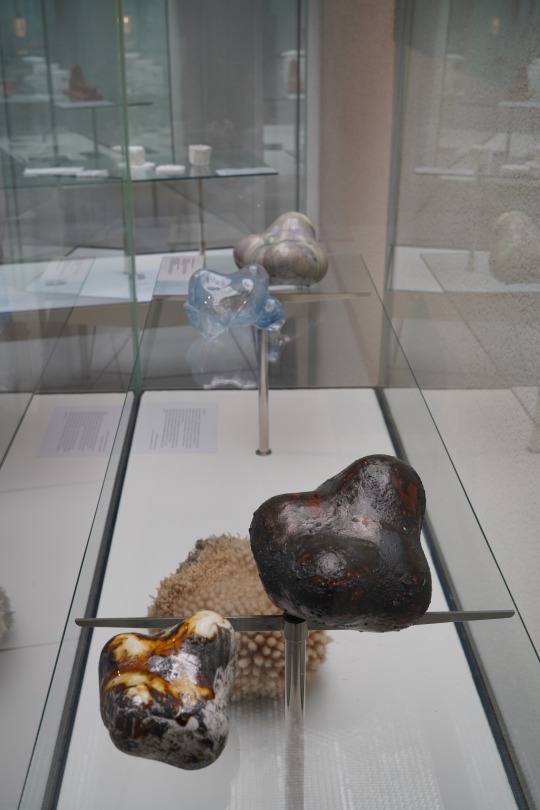
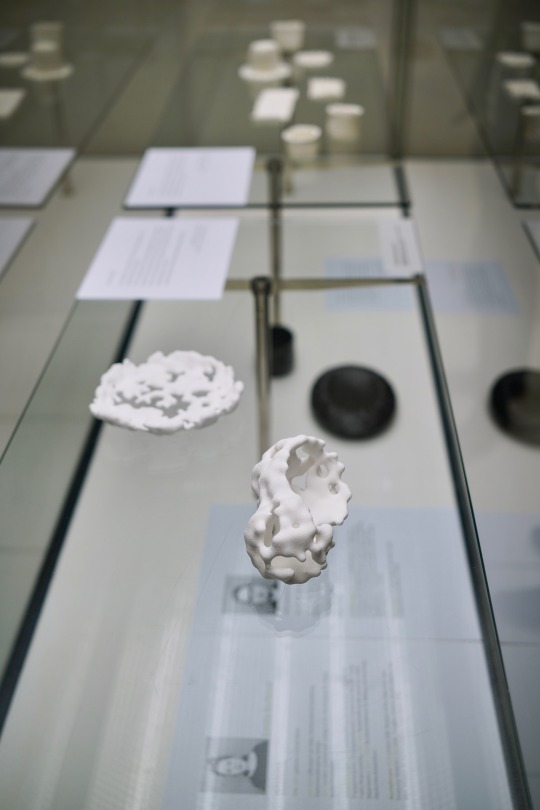
08.09.2019 - 23.02.2020 Art meets technology - competition ceramics from the 3D printer
3D printing is an important buzzword for industry 4.0. There is no other process that is as good at identifying innovative technologies of the future. Not only does it enable productions in small batch sizes, it also breaks down previous boundaries of design possibilities. The question of the extent to which this process can also be used in art is therefore exciting. The competition exhibition "Art meets Technology - Ceramics from the 3D Printer" follows it up.
From 8 September 2019 to 23 February 2020, the results of the competition will be on display, which KERAMION and WZR ceramic solutions GmbH jointly organized last year. Ten of the submitted designs were converted into ceramic material using the 3D process. The individual artists, designers and duos are Marco Wallraf, Dana Sáez, Daniel Rauch, Oliver Pietern, Levente Kiss and Christian Heuchel from O & O Baukunst, Arthur Homa, Steffen Hartwig, Johannes Friedrich Choe, Emilie Burfeind/Andreas Grimm and Helena Boddenberg.
For the first time, the competition is jointly organized by WZR ceramic solutions GmbH in Rheinbach and KERAMION.
08.09.2019 - 23.02.2020 Kunst trifft Technik – Wettbewerb Keramik aus dem 3D-Drucker
3D-Druck ist ein wichtiges Schlagwort für die Industrie 4.0. An keinem anderen Verfahren lassen sich innovative Techniken der Zukunft so gut festmachen. Es ermöglicht nicht nur Produktionen in kleinen Losgrößen, es bricht auch bisherige Grenzen der Gestaltungsmöglichkeiten auf. Spannend ist also die Frage, inwieweit dieses Verfahren auch in der Kunst angewandt werden kann. Ihr geht die Wettbewerbsausstellung „Kunst trifft Technik –Keramik aus dem 3D-Drucker“ nach.
Vom 8. September 2019 bis zum 23. Februar 2020 sind die Ergebnisse des Wettbewerbs zu sehen, den das KERAMION gemeinsam mit der WZR ceramic solutions GmbH bereits im letzten Jahr ausgelobt hat. Von den eingereichten Entwürfen wurden im 3D-Verfahren zehn Beiträge in keramisches Material umgesetzt. Bei den Einzelkünstlern bzw. -designern oder -duos handelt es sich um Marco Wallraf, Dana Sáez, Daniel Rauch, Oliver Pietern, Levente Kiss und Christian Heuchel von O & O Baukunst, Arthur Homa, Steffen Hartwig, Johannes Friedrich Choe, Emilie Burfeind/Andreas Grimm und Helena Boddenberg.
Der Wettbewerb wird zum ersten Mal gemeinsam von der WZR ceramic solutions GmbH in Rheinbach und dem KERAMION ausgelobt.
Die Jury bestand aus
Dr. Doris Krystof, Kuratorin der Kunstsammlung NRW, Düsseldorf Dr. Nele van Wieringen, Leiterin des Keramikmuseums Westerwald, Höhr-Grenzhausen Prof. Dr. Markus Holzbach, Hochschule für Gestaltung Offenbach Der Wettbewerb steht unter der Schirmherrschaft von Herrn Prof. Dr. Andreas Pinkwart, Minister für Wirtschaft, Innovation, Digitalisierung und Energie.
0 notes
Photo


Rundgang 2019 HfG Offenbach Exhibition at the Institute for Material Design
Rundgang 2019 HfG Offenbach Ausstellung im Institut für Materialdesign
0 notes

















